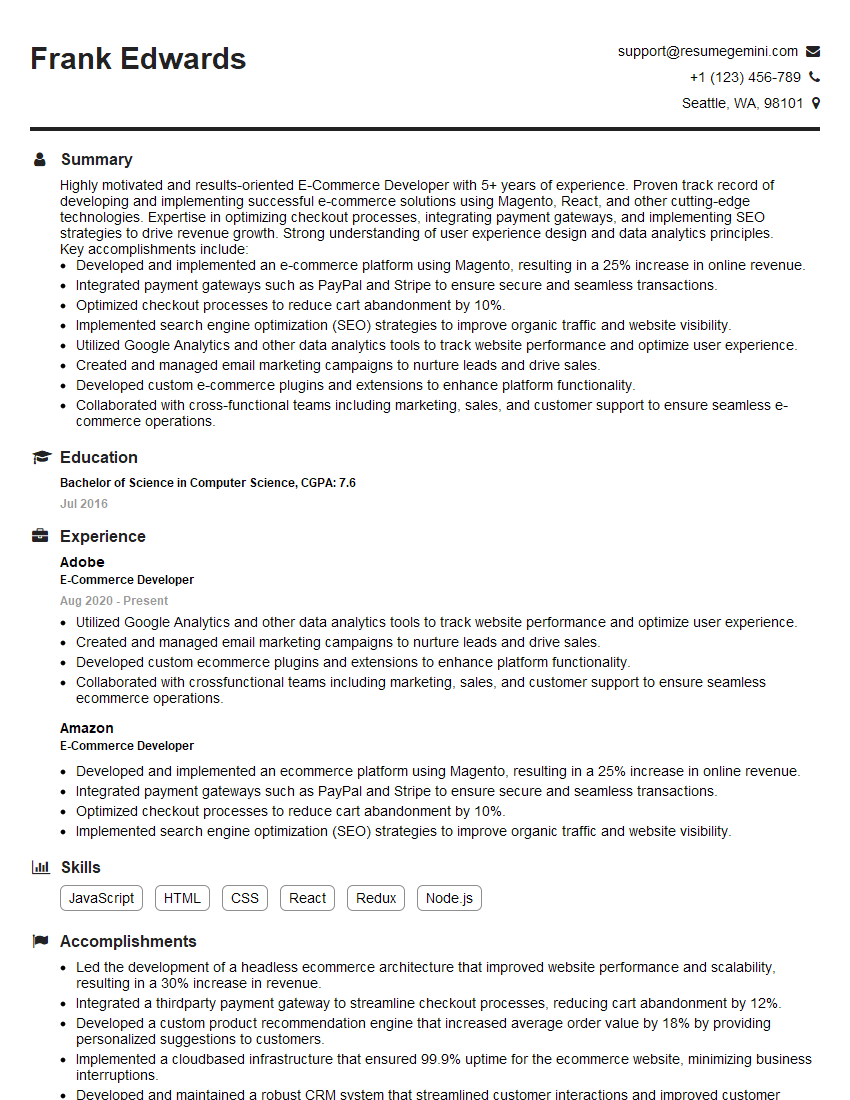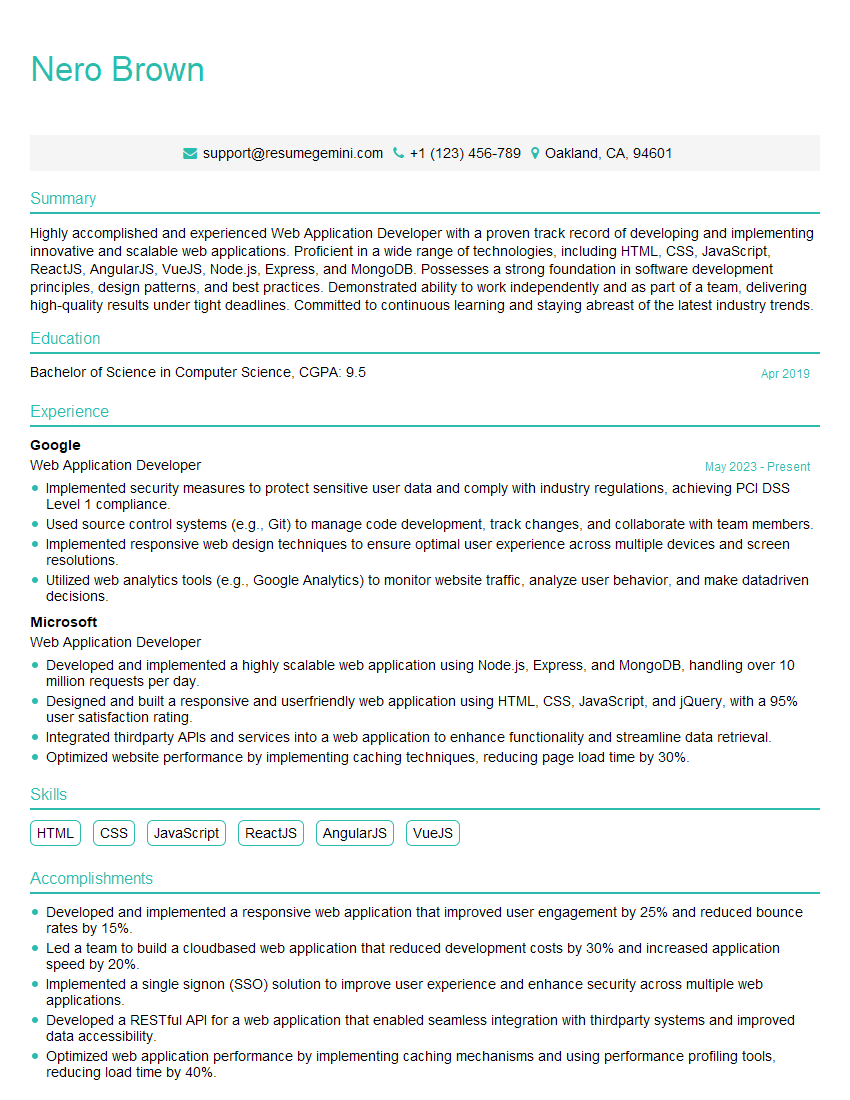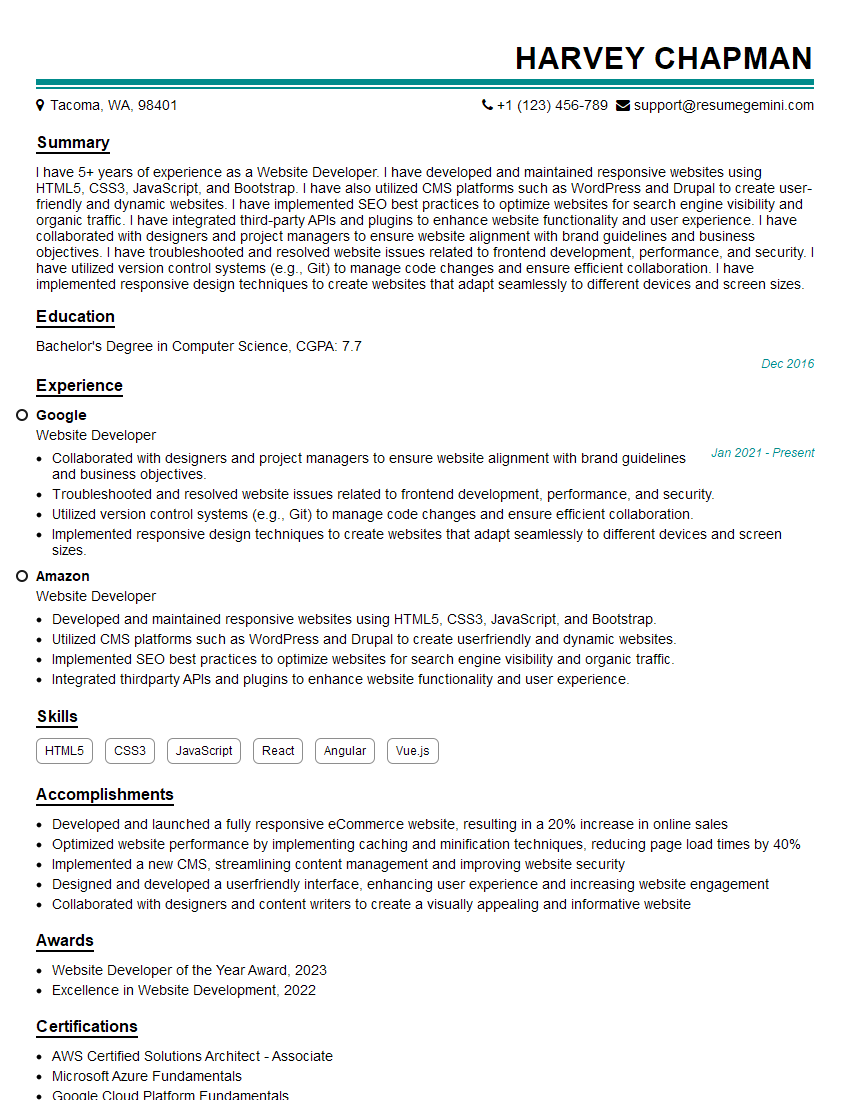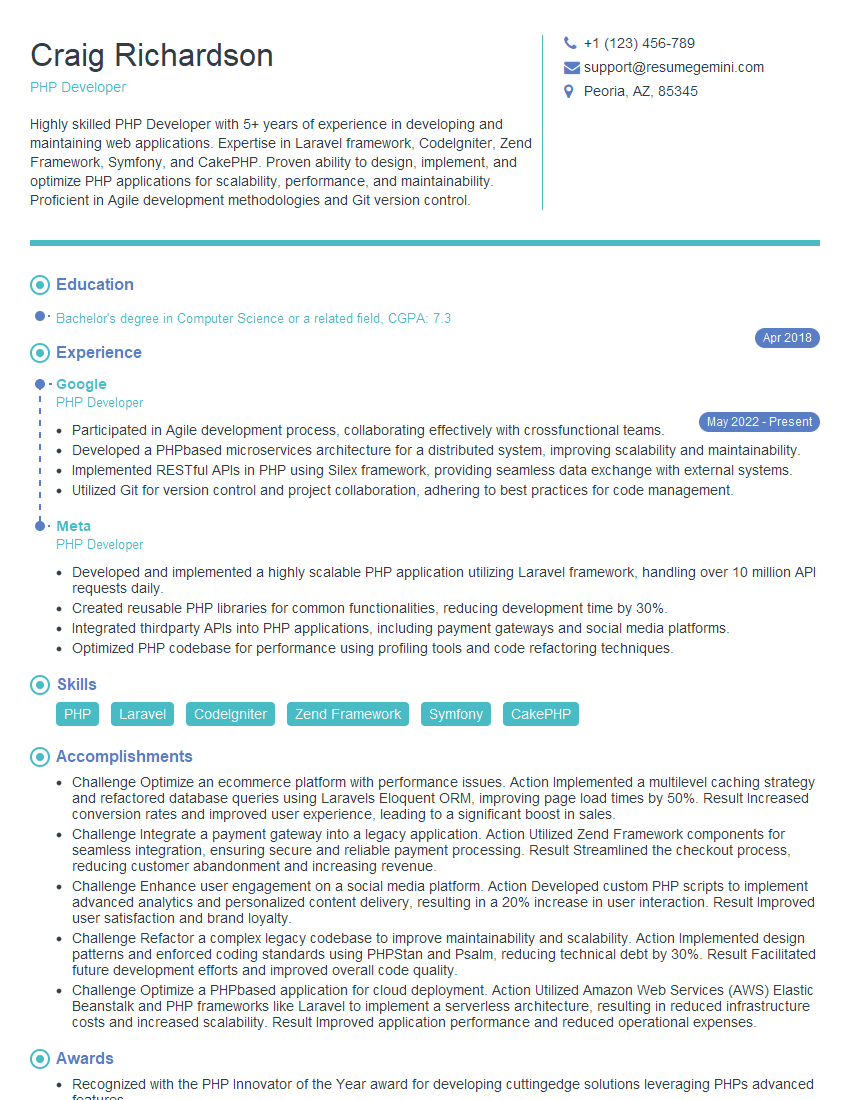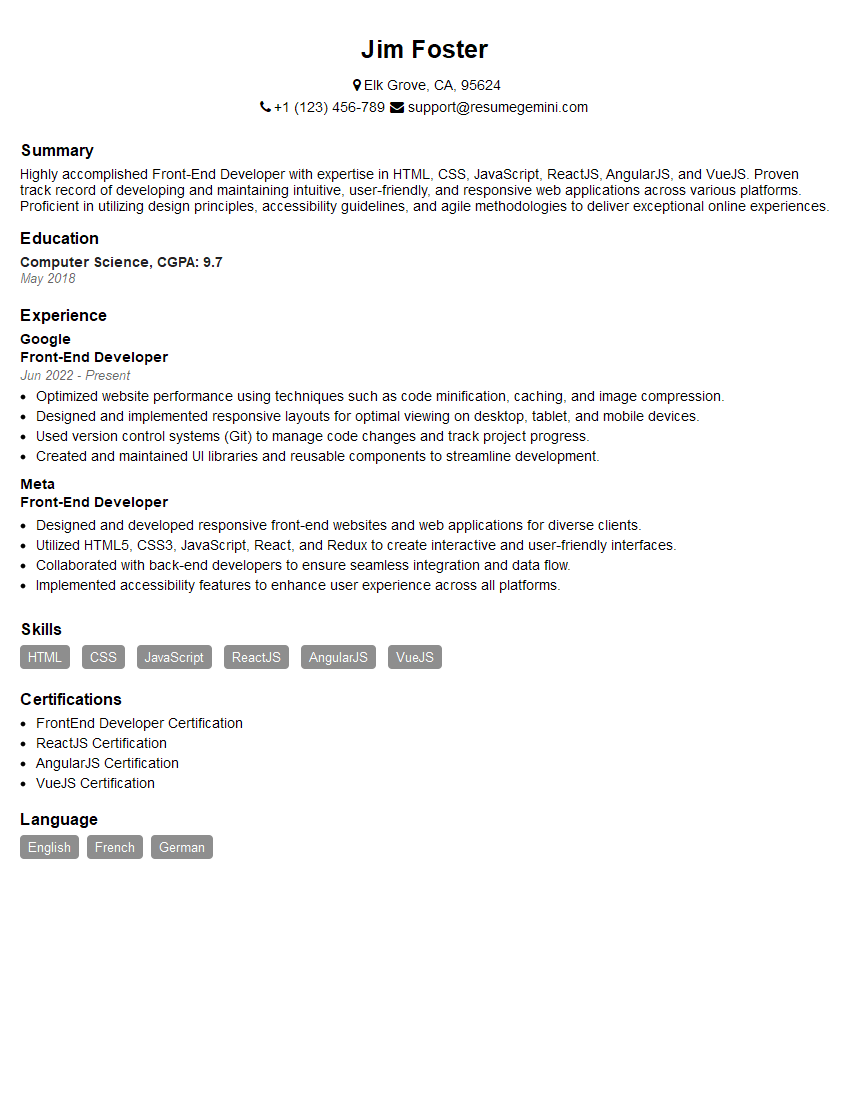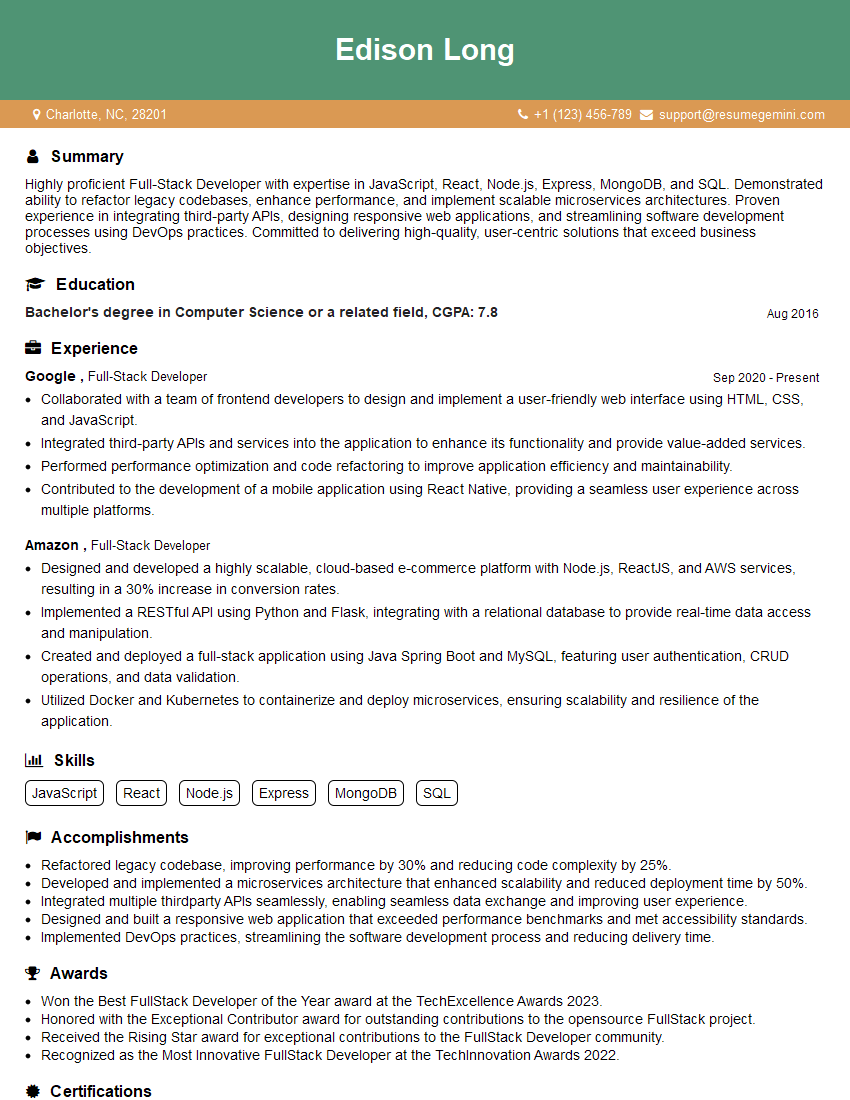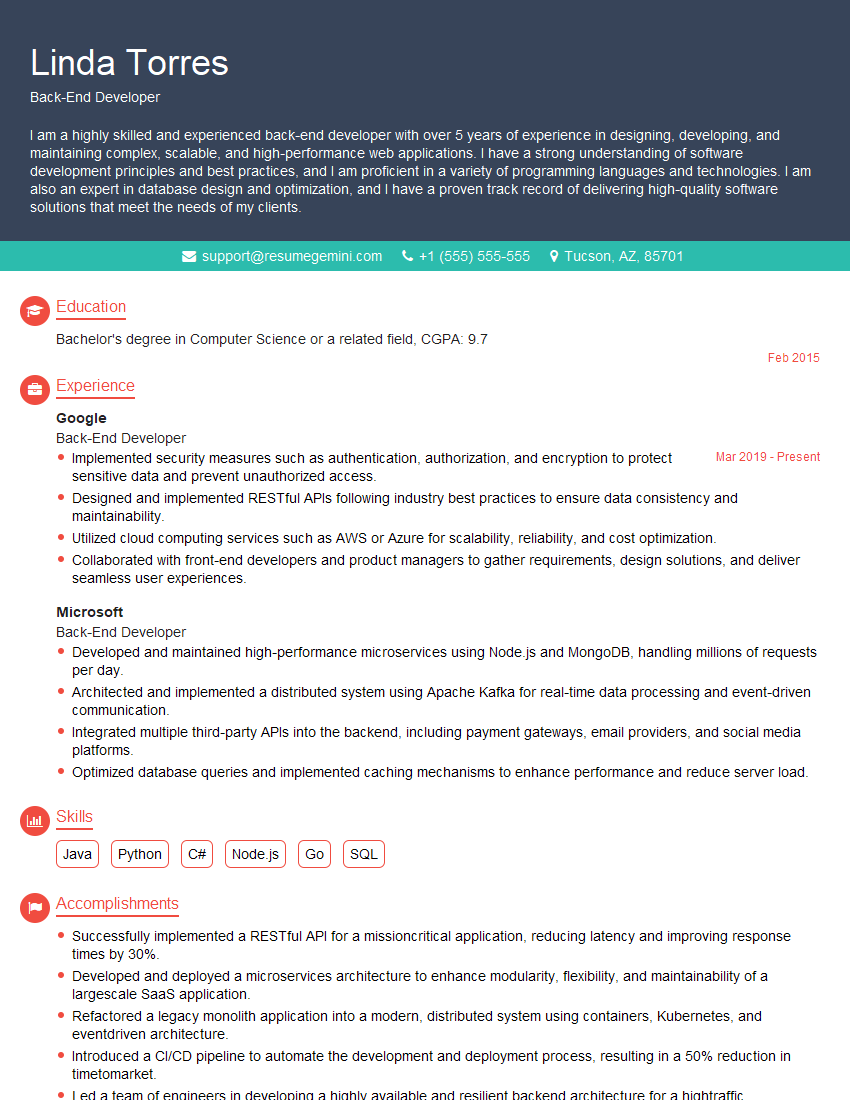The right preparation can turn an interview into an opportunity to showcase your expertise. This guide to Basic Web Development Knowledge interview questions is your ultimate resource, providing key insights and tips to help you ace your responses and stand out as a top candidate.
Questions Asked in Basic Web Development Knowledge Interview
Q 1. What is the difference between HTML, CSS, and JavaScript?
HTML, CSS, and JavaScript are the core technologies for building web pages. Think of them as the foundation, the paint, and the interactive elements of a house, respectively.
- HTML (HyperText Markup Language) provides the structure and content of a webpage. It uses tags to define elements like headings, paragraphs, images, and links. It’s like the blueprint of your house, outlining the rooms and their positions.
- CSS (Cascading Style Sheets) controls the visual presentation of the webpage. It styles elements defined in HTML, specifying things like colors, fonts, layout, and responsiveness. This is like the paint and decor of your house, making it visually appealing.
- JavaScript adds interactivity and dynamic behavior to a webpage. It allows for things like animations, form validation, and real-time updates. This is like the electrical wiring and appliances in your house; it’s what brings it to life.
For example, HTML might create a button, CSS would style that button with color and shape, and JavaScript would make the button respond to a click by performing an action.
Q 2. Explain the box model in CSS.
The CSS box model is a fundamental concept that describes how elements are rendered on a page. Imagine each HTML element as a box. This box has several components:
- Content: The actual text or images within the element.
- Padding: Space between the content and the border.
- Border: A line that surrounds the padding and content.
- Margin: Space between the element’s border and neighboring elements.
Understanding the box model is crucial for controlling the layout and spacing of elements on a webpage. For instance, you might use padding to create internal spacing within a button, a border to visually highlight it, and margin to separate it from other elements.
This is a box!This code snippet demonstrates the box model. The element has a red border, 10 pixels of padding, and 15 pixels of margin.
Q 3. What are semantic HTML tags and why are they important?
Semantic HTML tags describe the meaning or purpose of an element, not just its appearance. Unlike presentational tags like <font> (which is outdated), semantic tags provide context for both the browser and search engines. Examples include:
<header>: For introductory content.<nav>: For navigation links.<main>: For the primary content of a page.<article>: For self-contained articles or posts.<aside>: For sidebars or related content.<footer>: For footer content.
Using semantic HTML improves accessibility, SEO, and maintainability. Search engines understand the page structure better, leading to improved search rankings. Screen readers can use the semantic information to provide a better experience for visually impaired users. Finally, it makes the code easier to understand and maintain over time.
Q 4. Describe the different ways to include CSS in an HTML document.
There are three main ways to include CSS in an HTML document:
- Inline Styles: Applying CSS directly within an HTML tag using the
styleattribute. This is generally discouraged for larger projects because it makes maintaining the code very difficult.<p style="color: blue;"></p> - Internal Stylesheet: Embedding CSS within the
<style>tag inside the<head>section. Useful for smaller projects or when styles are specific to a single page.<head><style> p { color: blue; } </style></head> - External Stylesheet: Linking to a separate CSS file using the
<link>tag in the<head>section. This is the best practice for larger projects as it keeps CSS separate, making the code easier to maintain, reuse, and update across multiple pages.<head><link rel="stylesheet" href="styles.css"></head>
Q 5. What are the advantages and disadvantages of inline, internal, and external stylesheets?
Each method of including CSS has its own advantages and disadvantages:
- Inline Styles:
- Advantages: Quick and easy for single element styling.
- Disadvantages: Difficult to maintain for larger projects, reduces code readability, and isn’t reusable.
- Internal Stylesheet:
- Advantages: Convenient for smaller projects, keeps CSS within the HTML file.
- Disadvantages: Not reusable across multiple pages, can become unwieldy for large projects.
- External Stylesheet:
- Advantages: Easy to maintain, highly reusable across multiple pages, improves code organization, and allows for efficient caching.
- Disadvantages: Requires an extra HTTP request to load the stylesheet (though this can be mitigated with caching).
Generally, using external stylesheets is the best practice for well-organized and maintainable projects.
Q 6. Explain the concept of responsive web design.
Responsive web design is the approach of creating websites that adapt their layout and content to different screen sizes and devices (desktops, tablets, smartphones). This ensures a consistent and optimal user experience across all platforms. It involves using flexible layouts, fluid images, and media queries (discussed below) to achieve this.
Imagine building a house that can easily adjust its size and room arrangement to fit on a small plot of land or a large estate. That’s the essence of responsive design. It’s essential because more and more users are accessing websites on various devices. A non-responsive site might be difficult to navigate or even unreadable on a mobile device.
Q 7. What are CSS media queries?
CSS media queries are a powerful feature that allows you to apply different styles based on the characteristics of the device accessing the website. They let you tailor your CSS to various screen sizes, resolutions, orientations, and even device types. Think of them as conditional statements for your styles; they allow you to say ‘If the screen is this size, apply these styles’.
For example, you can use a media query to make text larger on smaller screens, hide certain elements on mobile devices, or change the layout entirely depending on the screen orientation.
@media (max-width: 768px) { body { font-size: 16px; } }This query applies a larger font size (16px) to the body if the screen width is 768 pixels or less.
Q 8. What are some common CSS frameworks?
CSS frameworks are pre-written collections of CSS styles that provide a structured and efficient way to style websites. They offer a consistent design language, reusable components, and often include responsive design features to adapt to different screen sizes. Think of them as pre-built sets of LEGO bricks – you can use them as-is or customize them to create your unique design.
- Bootstrap: One of the most popular frameworks, known for its extensive component library and responsive design capabilities. It’s a great starting point for beginners and widely used in professional projects.
- Tailwind CSS: A utility-first framework that provides a large set of low-level CSS utility classes. Instead of pre-built components, it empowers you to build your own styles from the ground up, offering great flexibility and customization.
- Materialize: Based on Google’s Material Design guidelines, it provides a clean and modern look and feel with pre-built components designed for a consistent user experience.
- Foundation: A robust and versatile framework known for its comprehensive features and responsive design features. It’s a solid choice for larger projects.
Choosing a framework depends on your project needs and preferences. If you need a quick and easy solution with ready-made components, Bootstrap might be ideal. For greater control and customization, Tailwind CSS is a strong contender.
Q 9. What are JavaScript variables and data types?
In JavaScript, variables are containers that hold data. Data types specify the kind of values a variable can store. JavaScript is dynamically typed, meaning you don’t explicitly declare the data type – JavaScript infers it based on the value assigned.
- Number: Represents numbers, both integers (e.g., 10) and floating-point numbers (e.g., 3.14).
- String: Represents text, enclosed in single (‘ ‘) or double quotes (” “).
- Boolean: Represents truth values, either
trueorfalse. - Null: Represents the intentional absence of a value.
- Undefined: Represents a variable that has been declared but hasn’t been assigned a value.
- Symbol (ES6): Represents a unique and immutable value.
- Object: A collection of key-value pairs. It’s a versatile data type used to structure complex data.
- BigInt (ES2020): Handles arbitrarily large integers.
Example:
let age = 30; // Number
let name = 'Alice'; // String
let isAdult = true; // Boolean
let city = null; // Null
let address; // UndefinedQ 10. Explain the difference between `let`, `const`, and `var` in JavaScript.
let, const, and var are all keywords used to declare variables in JavaScript, but they differ in their scope and mutability:
var: Function-scoped. If declared outside a function, it becomes globally scoped. It can be re-declared and updated within its scope. It’s considered an older approach, and modern JavaScript generally favorsletandconst.let: Block-scoped. It can be updated but not re-declared within its scope (e.g., within anifstatement or a loop). This helps prevent accidental variable re-declarations and improves code clarity.const: Block-scoped. It must be initialized at declaration and cannot be re-assigned or updated after its initial value. It’s best used for constants or values that shouldn’t change. Note that ifconstrefers to an object, the object’s *properties* can still be modified, but the variable itself cannot be reassigned to a different object.
Example illustrating scope:
function myFunction() {
var x = 10; // Function-scoped
let y = 20; // Block-scoped
const z = 30; // Block-scoped
if (true) {
let y = 40; // This doesn't affect the outer y
const z = 50; // This doesn't affect the outer z
}
console.log(x, y, z); // Outputs 10 20 30
}Q 11. What are JavaScript functions?
JavaScript functions are blocks of reusable code that perform a specific task. They enhance code organization, readability, and maintainability. Think of them as mini-programs within your larger program.
A function can accept input values (arguments) and return an output value. Functions promote modularity, allowing you to break down complex tasks into smaller, manageable units. This makes your code easier to understand, debug, and maintain.
Example:
function greet(name) {
return 'Hello, ' + name + '!';
}
let message = greet('Alice');
console.log(message); // Outputs: Hello, Alice!Q 12. Explain the concept of DOM manipulation in JavaScript.
DOM manipulation refers to changing the structure, style, or content of a web page’s HTML elements using JavaScript. The Document Object Model (DOM) is a programming interface for HTML and XML documents; it represents the page as a tree of objects. JavaScript allows us to traverse this tree, adding, removing, or modifying nodes (elements) dynamically.
For instance, we can add new elements, change text content, modify CSS styles, or respond to user interactions by altering the DOM. This is crucial for creating interactive and dynamic web applications.
Example (using jQuery for simplicity, although pure JavaScript can also do this):
// Add a new paragraph
$('#myDiv').append('This is a new paragraph.
');
// Change the text content of an element
$('#myHeading').text('New Heading Text');
//Change the CSS style of an element
$('#myParagraph').css('color', 'blue');In a professional setting, DOM manipulation is essential for creating features like interactive forms, updating content without page reloads (AJAX), building single-page applications (SPAs), and creating visually appealing and responsive user interfaces.
Q 13. What are JavaScript events?
JavaScript events are actions or occurrences that happen in the browser, often triggered by user interactions like clicks, mouseovers, or keyboard presses. They provide a way to make web pages interactive and dynamic.
When an event occurs, JavaScript code associated with that event can be executed. This allows you to respond to user actions and update the web page accordingly. Common events include:
click: Occurs when a mouse button is clicked.mouseover: Occurs when the mouse pointer moves over an element.mouseout: Occurs when the mouse pointer moves out of an element.keydown: Occurs when a key is pressed down.keyup: Occurs when a key is released.submit: Occurs when a form is submitted.load: Occurs when an element or the entire page has finished loading.
Example:
document.getElementById('myButton').addEventListener('click', function() {
alert('Button clicked!');Q 14. How do you handle asynchronous operations in JavaScript?
Asynchronous operations in JavaScript are tasks that don't block the execution of other code while they are running. This is crucial for performance, especially in web development where tasks like fetching data from a server can take time. Blocking operations would freeze the browser while waiting, resulting in a poor user experience.
JavaScript uses several mechanisms to handle asynchronous operations:
- Callbacks: Functions passed as arguments to other functions, executed after an asynchronous operation completes. They are a simpler approach, but for complex scenarios, they can lead to what's known as 'callback hell' (nested callbacks making code difficult to read).
- Promises: Objects that represent the eventual completion (or failure) of an asynchronous operation. They provide a cleaner way to handle asynchronous code than callbacks.
- Async/Await: An ES2017 feature that builds on promises, making asynchronous code look and behave more like synchronous code, improving readability and maintainability.
Example using async/await and fetch (a modern way to make network requests):
async function fetchData() {
try {
const response = await fetch('https://api.example.com/data');
const data = await response.json();
console.log(data);
} catch (error) {
console.error('Error fetching data:', error);
}
}In a professional context, proper handling of asynchronous operations is paramount for building responsive and efficient web applications. This ensures a smooth user experience even when dealing with time-consuming tasks like data retrieval or image loading.
Q 15. What are promises and async/await?
Promises and async/await are powerful JavaScript features for handling asynchronous operations more cleanly and efficiently. Imagine you're ordering food – you don't just instantly get your meal; there's a delay. Promises represent the eventual result of an asynchronous operation (like a network request), whether it's success or failure. async/await makes working with promises much more readable, resembling synchronous code.
A Promise has three states: pending (initial state), fulfilled (operation succeeded), and rejected (operation failed). You can attach handlers (.then() for success, .catch() for failure) to a promise to process the result.
const myPromise = new Promise((resolve, reject) => { // Simulate an asynchronous operation setTimeout(() => { const success = true; if (success) { resolve('Operation successful!'); } else { reject('Operation failed!'); } }, 2000); }); myPromise .then(result => console.log(result)) .catch(error => console.error(error)); async/await builds upon promises. The async keyword makes a function return a promise. await pauses execution within an async function until a promise resolves.
async function fetchData() { try { const response = await myPromise; // Waits for myPromise to resolve console.log(response); } catch (error) { console.error(error); } } fetchData(); In web development, this is crucial for handling events like fetching data from a server without blocking the user interface. Instead of making the entire page freeze while waiting, async/await keeps things responsive.
Career Expert Tips:
- Ace those interviews! Prepare effectively by reviewing the Top 50 Most Common Interview Questions on ResumeGemini.
- Navigate your job search with confidence! Explore a wide range of Career Tips on ResumeGemini. Learn about common challenges and recommendations to overcome them.
- Craft the perfect resume! Master the Art of Resume Writing with ResumeGemini's guide. Showcase your unique qualifications and achievements effectively.
- Don't miss out on holiday savings! Build your dream resume with ResumeGemini's ATS optimized templates.
Q 16. What are some popular JavaScript libraries or frameworks?
The JavaScript ecosystem boasts a wealth of popular libraries and frameworks. The choice depends on project needs and personal preference.
- React: A component-based library for building user interfaces. It's known for its virtual DOM, which optimizes updates, and its large community support. Ideal for single-page applications (SPAs) and complex interfaces.
- Angular: A full-fledged framework for building complex web applications. It offers a structured approach with features like dependency injection and two-way data binding. Excellent for large-scale enterprise applications.
- Vue.js: A progressive framework that's easy to learn and integrate into existing projects. It offers a balance between flexibility and structure. Suitable for both small and large projects.
- jQuery: Though older, it's still relevant for simplifying DOM manipulation and AJAX calls. It's a lightweight library, perfect for smaller projects or adding quick functionality to existing sites.
- Node.js (with Express.js): Not a front-end framework, but Node.js is a JavaScript runtime environment that allows you to run JavaScript on the server-side. Express.js is a popular framework built on Node.js, used to create APIs and server-side logic.
Each framework has its strengths and weaknesses, and choosing the right one often depends on factors like project size, team expertise, and performance requirements. For example, React might be great for a dynamic, interactive website but jQuery might suffice for a simple site requiring minimal JavaScript.
Q 17. Explain the difference between GET and POST HTTP requests.
GET and POST are two fundamental HTTP request methods used to interact with servers. Think of them as different ways to communicate with a restaurant: GET is like looking at the menu (requesting information), while POST is like ordering food (submitting data).
GETrequests are used to retrieve data from a server. The data is appended to the URL as query parameters.GETrequests are idempotent, meaning they produce the same result with multiple identical requests. They are typically used for retrieving data, and the data sent is visible in the browser's URL.POSTrequests are used to submit data to a server to create or update a resource. The data is sent in the request body, not the URL.POSTrequests are not idempotent, as repeated requests may have different results (e.g., creating multiple new records). They are commonly used for submitting forms, making changes to data, and maintaining data privacy as the data is not visible in the URL.
Example: A GET request might look like /products?category=electronics, while a POST request might send user registration details in the request body to create a new user account.
Q 18. What is RESTful API?
A RESTful API (Representational State Transfer Application Programming Interface) is a set of architectural constraints for designing network APIs. It's a way to structure how your web application communicates with a server. Think of it as a standardized way to order from a restaurant – the menu (API endpoints) is clear, the ordering process (HTTP methods) is predictable, and the food (data) is presented consistently.
Key principles of a RESTful API:
- Client-Server Architecture: Clear separation of concerns between the client and server.
- Statelessness: Each request contains all the information needed to process it; the server doesn't store client context between requests.
- Cacheability: Responses can be cached to improve performance.
- Uniform Interface: A consistent way to interact with resources using standard HTTP methods (
GET,POST,PUT,DELETE). - Layered System: The client doesn't need to know the internal structure of the server.
- Code on Demand (optional): The server can extend client functionality by transferring executable code.
Following REST principles leads to APIs that are easy to understand, use, and maintain. For example, a RESTful API might use GET /users to retrieve a list of users, POST /users to create a new user, GET /users/123 to retrieve a specific user, and DELETE /users/123 to delete a user.
Q 19. What is JSON and how is it used in web development?
JSON (JavaScript Object Notation) is a lightweight data-interchange format. It's like a universal language for computers to share data efficiently. It's text-based, easily readable by both humans and machines, and is commonly used in web development for transmitting data between a server and a web application.
JSON is structured as key-value pairs, similar to a JavaScript object. This makes it easy to parse and use in JavaScript.
// Example JSON data { "name": "John Doe", "age": 30, "city": "New York" } In web development, JSON is frequently used to:
- Send data from the server to the client: A server might respond to a request with JSON data representing a list of products or user information.
- Send data from the client to the server: A client might send JSON data in a form submission or AJAX request.
- Store data in local storage or cookies: JSON's simple structure makes it easy to store data persistently on the client side.
JSON's simplicity, readability, and widespread support make it the go-to format for data exchange in web applications.
Q 20. What is AJAX?
AJAX (Asynchronous JavaScript and XML) is a technique for updating parts of a web page without reloading the entire page. It's like having a silent waiter bringing you updates to your meal (web page) as they become ready, rather than making you wait for the entire course to be completed at once.
AJAX uses JavaScript to communicate with a server in the background. While the original term included XML, JSON is now more commonly used for data exchange because of its simplicity and efficiency. The key is the asynchronous nature—the user interface remains responsive while data is fetched from the server.
Example use cases:
- Auto-suggest in search boxes: As you type, AJAX fetches matching suggestions from the server.
- Updating content without page reloads: Updating a news feed, chat messages, or email inbox without a full page refresh.
- Interactive maps: Loading map tiles as the user pans or zooms.
Essentially, AJAX enables a more dynamic and responsive user experience by minimizing page reloads and keeping the user engaged.
Q 21. What is a web server?
A web server is a computer program that runs on a computer (server) and listens for incoming requests from clients (like web browsers). Think of it as a restaurant kitchen: It receives orders (requests) from customers (clients), processes them, and sends back the finished dishes (responses).
When you enter a website address in your browser, your browser sends a request to the web server hosting that website. The server processes the request (locating files, running code, etc.), generates a response (usually an HTML page), and sends it back to your browser, which then displays the website.
Common web servers include Apache, Nginx, IIS. These servers handle many tasks, such as:
- Accepting client requests: Listening for incoming HTTP requests.
- Processing requests: Determining which file or script to execute.
- Generating responses: Creating the appropriate response based on the request (HTML, images, data, etc.).
- Sending responses: Returning the response to the client.
- Managing resources: Ensuring efficient use of server resources.
Without a web server, websites wouldn't exist; it's the essential component responsible for serving web pages and other resources to users.
Q 22. What is the purpose of a database in web development?
In web development, a database serves as a structured repository for storing and managing large amounts of data. Think of it as a highly organized filing cabinet, but instead of paper files, it holds digital information. This data is crucial for dynamic websites, allowing them to personalize content, store user information, and much more. Without a database, websites would be static and limited in functionality.
For example, an e-commerce website uses a database to store product details (name, price, description, images), customer information (name, address, order history), and order details (products ordered, shipping address, payment information). This allows the site to display the correct products, process orders, and track customer activity.
Q 23. What are some common database systems used in web development?
Several database systems are commonly used in web development, each with its own strengths and weaknesses. The choice often depends on the project's scale, complexity, and specific needs.
- Relational Databases (SQL): These are the workhorses of many large applications. They organize data into tables with rows and columns, enforcing relationships between tables. Popular examples include MySQL, PostgreSQL, and Microsoft SQL Server. They are well-suited for structured data and complex queries.
- NoSQL Databases: These are designed to handle large volumes of unstructured or semi-structured data more efficiently than relational databases. They offer flexibility in data modeling and scalability. Popular examples include MongoDB (document database), Cassandra (wide-column store), and Redis (in-memory data structure store). They're great for applications like social media, where data might not fit neatly into rows and columns.
Choosing between SQL and NoSQL depends on the nature of your data. If you need strict data integrity and relationships, SQL is often preferred. If you need flexibility and scalability for large datasets, NoSQL might be a better fit.
Q 24. Explain the concept of version control (e.g., Git).
Version control, most commonly using Git, is a system for tracking changes to files over time. It's like having a detailed history of your project's evolution, allowing you to revert to previous versions, compare changes, and collaborate effectively with others. Imagine writing a document and saving multiple versions with dates – Git does this for your entire codebase.
Git allows multiple developers to work on the same project simultaneously without overwriting each other's work. Each developer has their own local copy of the code, and they can commit changes to their local repository. Then, they can push these changes to a remote repository (like GitHub, GitLab, or Bitbucket) where others can review and merge the changes. This collaborative workflow significantly reduces conflicts and improves the overall development process. Branching is a key feature, enabling parallel development on different features without affecting the main codebase.
Q 25. What is a common workflow for deploying a website?
Deploying a website involves making your project live and accessible to the public. A common workflow might look like this:
- Code Versioning: Ensure your code is committed to version control (Git).
- Testing: Thoroughly test your website in a staging environment to simulate the production environment and identify any bugs.
- Build Process: If necessary, build your application (e.g., compiling code, bundling assets).
- Deployment to Server: Use a deployment method like FTP, Git deployment (using tools like Git hooks), or a continuous integration/continuous deployment (CI/CD) pipeline (using tools like Jenkins, GitLab CI, or GitHub Actions).
- Database Migration: If your website uses a database, make sure to deploy the database changes as well.
- Verification: After deployment, verify that everything works as expected on the live server.
The specific steps might vary based on your project’s complexity and the tools you are using, but this outlines a general approach. Using a CI/CD pipeline automates much of this process, making deployments more frequent and reliable.
Q 26. Describe your experience with debugging web applications.
Debugging is an essential part of web development. I'm proficient in using browser developer tools (like Chrome DevTools and Firefox Developer Tools) to inspect the HTML, CSS, and JavaScript code, identify errors, and track down the source of problems. I'm also experienced with using debugging tools within my chosen IDE (Integrated Development Environment) to step through code, set breakpoints, and examine variables.
For instance, I recently used browser developer tools to identify a CSS conflict that was causing unexpected layout issues on a responsive website. By stepping through the code, I was able to pinpoint the conflicting styles and adjust them accordingly. I often use the console to log variables and track the flow of execution.
Beyond basic debugging, I am comfortable using logging frameworks (like Log4j or Winston) in server-side code to track issues and monitor application performance. These tools are instrumental for identifying and resolving more complex problems.
Q 27. Explain your approach to troubleshooting a broken website.
My approach to troubleshooting a broken website is systematic and involves several steps:
- Gather Information: First, I identify the nature of the problem – what exactly is broken? Is it a visual issue, a functionality issue, or a server-side error? Gathering information from error logs, user reports, or by testing the site myself is key.
- Check Server Status: Ensure the server is running and accessible. Issues like server downtime or network problems can be the root cause.
- Inspect Browser Console: I look for JavaScript errors, network requests that failed, or warnings in the browser's developer tools.
- Review Recent Changes: If the site recently underwent updates or deployments, I focus on those changes as likely culprits. Version control is invaluable here.
- Test Different Browsers/Devices: The problem might be browser-specific or related to device compatibility.
- Check Logs: Server-side logs often contain critical information about errors that may not be visible on the front end.
- Isolate the Problem: I try to narrow down the source of the problem, isolating sections of code or components to identify the exact cause.
This methodical approach allows me to quickly diagnose and fix the problem, focusing on the most likely causes first. Prioritizing information gathering ensures I don't waste time on irrelevant aspects.
Q 28. Describe a time you had to learn a new technology quickly for a web development project.
On a recent project, we needed to integrate a new payment gateway that used a completely unfamiliar API. I had only limited prior experience with APIs in general. My approach involved several steps:
- Documentation Dive: I started by thoroughly reviewing the payment gateway's API documentation. I looked for examples, tutorials, and any available code snippets.
- Testing and Experimentation: I set up a local testing environment to experiment with the API. I started with simple requests to get a feel for the API's structure and behavior.
- Online Resources: I searched for online tutorials, blog posts, and Stack Overflow questions related to the API. This helped me understand best practices and common pitfalls.
- Team Collaboration: I actively collaborated with my team, seeking their guidance and expertise where needed. This was valuable for troubleshooting and resolving any difficulties.
Within a few days, I was able to successfully integrate the payment gateway, learning a new technology quickly through a combination of self-learning, documentation review, and collaborative problem-solving. This experience highlighted the importance of resourcefulness and the ability to quickly adapt to new technologies in the fast-paced world of web development.
Key Topics to Learn for Basic Web Development Knowledge Interview
- HTML Fundamentals: Understanding HTML tags, semantic HTML5, structuring web pages, and working with forms. Practical application: Building a simple landing page from scratch.
- CSS Styling: Mastering CSS selectors, box model, flexbox and grid layouts for responsive design, and applying styling consistently. Practical application: Creating a visually appealing and responsive webpage.
- JavaScript Basics: Working with variables, data types, operators, control flow, functions, DOM manipulation, and event handling. Practical application: Adding interactive elements to a static webpage.
- Version Control (Git): Understanding Git basics, branching, merging, and using Git for collaborative development. Practical application: Managing code changes and collaborating on a project using a Git repository.
- Responsive Web Design Principles: Understanding different screen sizes, media queries, and creating websites that adapt to various devices. Practical application: Ensuring your website looks great on desktops, tablets, and mobile phones.
- Web Development Tools: Familiarity with common web development tools like text editors (VS Code, Sublime Text), debugging tools, and browsers' developer tools. Practical application: Efficiently troubleshooting and improving your code.
- Basic HTTP Concepts: Understanding HTTP requests, methods (GET, POST), status codes, and the client-server model. Practical application: Diagnosing network issues and understanding how websites work on a fundamental level.
- Problem-Solving and Debugging Techniques: Developing skills to identify and fix errors in your code effectively. Practical application: Using debugging tools and logical reasoning to solve coding challenges.
Next Steps
Mastering basic web development knowledge is crucial for launching a successful career in this ever-evolving field. A strong foundation in these key areas will significantly enhance your interview performance and open doors to exciting opportunities. To further strengthen your job prospects, create an ATS-friendly resume that effectively highlights your skills and experience. ResumeGemini is a trusted resource that can help you build a professional and impactful resume. Examples of resumes tailored to Basic Web Development Knowledge are available to help you get started.
Explore more articles
Users Rating of Our Blogs
Share Your Experience
We value your feedback! Please rate our content and share your thoughts (optional).
What Readers Say About Our Blog
Hi, I’m Jay, we have a few potential clients that are interested in your services, thought you might be a good fit. I’d love to talk about the details, when do you have time to talk?
Best,
Jay
Founder | CEO
